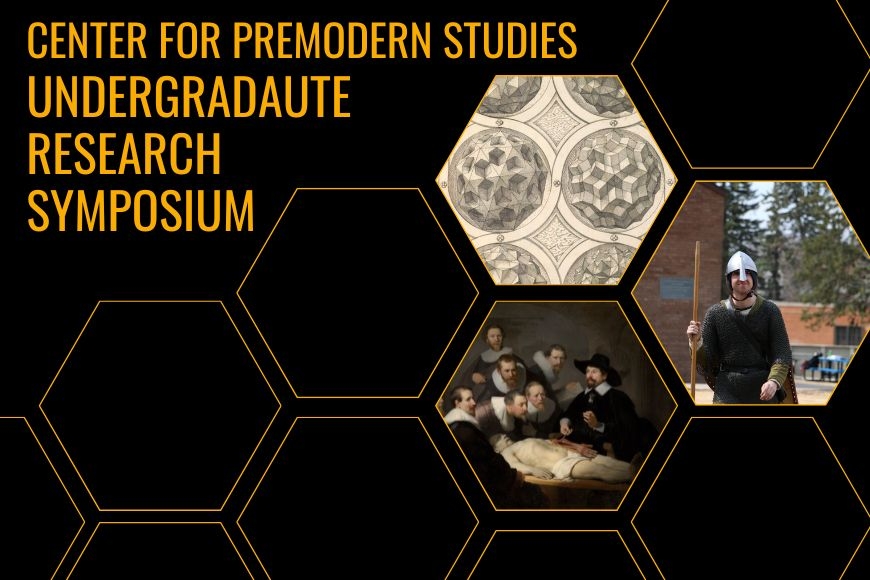Center for Premodern Studies Undergraduate Research Symposium
271 19th Ave S
Minneapolis,
MN
55455
About:
Leo Dannersmith, King Harold Goodwineson’s 200-mile March to the Nattle of Stamford Bridge: A Qualitative Study Using Experimental Archeology
Abstract: This talk focuses on King Harold Goodwineson’s march to the battle of Stamford Bridge in 1066 CE. I will discuss my experimental attempt to recreate this 200-mile march and what it teaches us about this event and eleventh-century military logistics.
Bio: Leo Dannersmith is a third-year undergraduate at the university of Minnesota. He is a history major and medieval studies minor and the undergraduate aid for the Premodern Studies Center. Though his focus is centered around knighthood and the 14th century he has a broader interest in experimental archeology around arms, armor, and travel during the entirety of the middle ages.
Fina Mooney, Cut, Fold, Paste: Metamorphosis of the Net
Abstract: The net is a term used to describe the unfolded three-dimensional mapping of a solid when laid out flat onto a surface. Academically recognized as both a legitimate representation of mathematics and spatial consciousness, the net makes its pioneering appearance in Albrecht Dürer’s 1525 Underweysung der Messung or A Manual of Measurement of Lines, Area, and Solids, by Means of Compass and Ruler Assembled by Albrecht Dürer for the Use of All Lovers of Art with Appropriate Illustrations Arranged to be Printed in the Year MDXXV [1525]. Grounding geometry in its physical and material roots practiced by both the hand and the head, I will argue that Dürer’s nets invite a sensorial didactic of manipulating form that is not just mathematical but also creative. By explaining or rather unfolding the metamorphosizing complexities of form in space, Dürer opens up a paradigm to the abstract and natural world. Paralleling the framework of perspective, the net becomes a phenomenological structure for cutting the tensions of spatialization, representation, and melancholic metamorphosis. Pictured through the material language of geometry in the 16th century, I will then use the case study of Dürer’s Underweysung der Messung as a monument to the duality of art and science as a shared act manifested through kinesthetic experience and curiosity.
Bio: Fina Mooney is a senior majoring in Art History with two minors in Italian and Museum and Curatorial Studies. From the NE Minneapolis arts community as a technical artist herself, she has always been fascinated by the subject of art history and the opportunities it provides for exploration into the complex world of art making. Outside of her time working as the office assistant to the wonderful Art History Department, Fina has assisted in relaunching the Undergraduate Art History Club as Vice President and head of marketing. Receiving scholarship to study abroad in both Japan and Italy, Fina has strived to think critically about the methodology and discipline of art history across multiple geographies and traditions. Fina has completed numerous independent research studies in her undergraduate career including the Dean's First-Year Research and Creative Scholars Award with Dr. Seastrand, and the Undergraduate Research Opportunities Program with Dr. JB Shank. This past semester Fina has also thoroughly enjoyed becoming a participant in the Newberry Library of Chicago’s Center for Renaissance Studies Undergraduate Seminar on The World in Books. Most often found camped out on the third floor of Wilson library, she also loves the wonderful collections of rare books and museums on campus. Both driven and passionate about the history of art, Fina will be continuing her academic interests this fall by pursing a Master’s degree in Art History at the Courtauld Institute of Art in London in hopes to follow her studies occupationally.
Lauren Toensig, Thinking the Body: Reorienting Rationality in Kant's Transcendental Idealism
Abstract: In the Western philosophical tradition, the rational mind or soul has held a position of prominence in discussions of human nature. Frequently, philosophers praised reason as the ideal or divine side of humanity, raising it in both importance and value over our animal bodies. I argue that, despite this trend, scholars still frequently referred to the body as an important means of understanding the human condition. I propose a reading of the philosophy of Immanuel Kant, often regarded as one of the greatest champions of reason in the philosophical canon, that incorporates the body itself into the possibility for human beings to live as thinking things.
Bio: Lauren Toensing is a senior at the University of Minnesota majoring in philosophy and art history. She is currently interested in questions about the mind and body, personal and social identity, and the place of the human body in the visual arts. She hopes to attend graduate school in philosophy to study Idealist philosophy, with a focus on Kant and neo-Kantian traditions.
